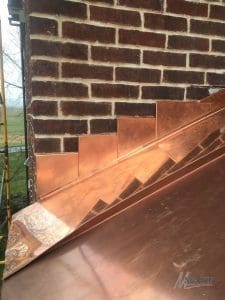
What is roof flashing for and is roof flashing necessary?
Your roof is covered with asphalt shingles or some other type of roofing material. While these are protection for your home, keeping the rain and other elements out of your home, they can’t do it alone. Every roofing material needs a form of roof flashing too in order to do the protection job intended.
So, what is roof flashing? Roof flashing is a flat metal stripping that is made from aluminum, copper, or steel. It is instead on a roof so that water can’t get up under the roofing shingles or other roofing material. It is an added layer of protection that keeps the underlayment and your home safe from roof leaks.
There are certain sections of a roof where roof flashing is critical for the safety of your roof. Those areas include where walls and roof surface meet, roof valleys, and protrusions like the skylight and vents. Roof flashing is critical around the chimney and at the roof edge too.
What are the different types of roof flashing?
There are several types of roof flashing, each has a specific purpose. A partial list of those different roof flashings is:
Common Roof Flashing Types
Continuous roof flashing: A long piece of continuous roof flashing that protects where a vertical wall and sloped roof meet.
Drip edge roof flashing: Usually installed along the eaves under the roofing felt to keep water dripping off the roof.
Step roof flashing: A rectangular piece at a 90-degree bend in the center used in an overlapping manner that prevents water from getting behind the walls.
Valley roof flashing: A metal flashing in a W-shape that is installed on top of roofing felt where two roof valleys join.
Vent pipe roof flashing: This cone-shaped flashing is installed around vent pipes over the shingles.
Additional Roof Flashing Types
Base roof flashing: Fits around chimneys to ensure rain is redirected out and down the roof.
Counter roof flashing: Installed opposite to or above base flashing as the second part of a two-part roof flashing team.
Cap roof flashing: This L-shaped roof flashing is installed to lay flat against the roof, windows, and other fittings to ensure water runs off such as windows. The shape of the structure runs the other direction and off the roof.
Chimney roof flashing: Roof flashing is necessary around chimneys to prevent water from pooling in the gaps between the roof and the chimney.
Saddle roof flashing: This flashing covers any protruding beams or attached railing.
Skylight roof flashing: Most skylights have built-in roof flashing to keep water from seeping around and inside the house. If a skylight doesn’t have this flashing the roofing contractor will install one.
Kick-out roof flashing: This roof flashing bridges any gap between the step flashing and the gutter to direct water to the gutter.
What is counter flashing in roofing?
Counter roof flashing prevents moisture from getting behind a headwall or sidewall vertical flashing. In some cases, a roofing contractor will use the exterior wall covering as the counter roof flashing, but most commonly there is a separate counter roof flashing installed.
What is drip edge flashing?
Drip edge roof flashing is a flat thin metal flashing installed at the roof edges to control water flowing away from the fascia while it protects the underlying roof components.
Does flashing go over or under shingles?
It depends actually, roof flashing is installed both ways. Picture rain coming down on your roof with the wind blowing. You need something in place to divert that rain before it gets behind or under the shingles.
So, installing the roof flashing over the shingles may be the best scenario for one area, whereas installing roof flashing under the shingles may work better in a different area of the roof. Roof flashing should be installed so that it diverts water around any protrusion skylights and vents, or where the shingles are parallel to the wall, install flashing where water can’t get under the shingles.
Which is better aluminum or galvanized roof flashing?
If you’re looking for a long lifespan with durability, aluminum roof flashing is the best choice ad easy to install. If cost is your concern, galvanized-steel roof flashing is your best option but isn’t as durable and may need replacing before the roofing material does.
Is roof flashing required by code?
If you’re asking about building codes, that can vary from city to city, county to county. You’ll need to check with the local governing offices for that information. If you are asking about the roofing material manufacturer, most will require roof flashing to be installed at the time the new roofing material is installed. The roof flashing used must follow their design and system with proper material application requirements followed.
How long should roof flashing last?
There are several variables that can affect roof flashing’s life expectancy. When installed by a roofing professional with proper procedures and the homeowner maintains regular roof inspections and consistent maintenance, flashing can give you up to thirty years of longevity. Good quality and properly installed roof flashing won’t need repairing or replacing until the shingles are replaced unless a significant weather event pulls the flashing off or loosens it. Call (610) 689-3737 today for your roof flashing needs in Oley, PA.

























